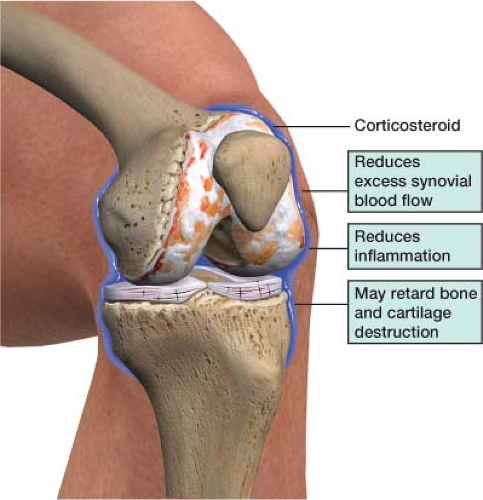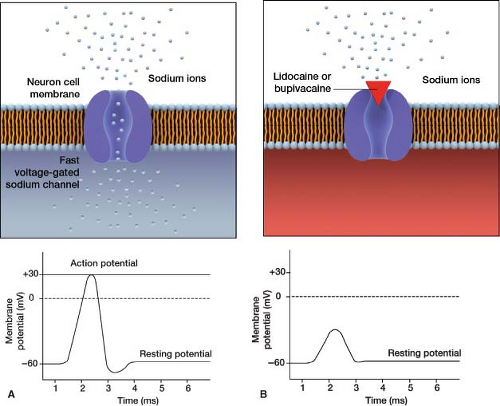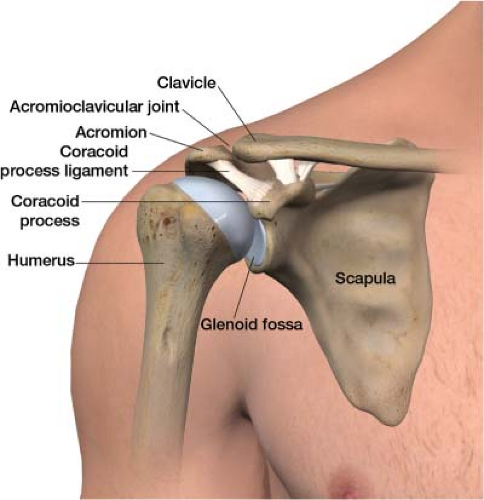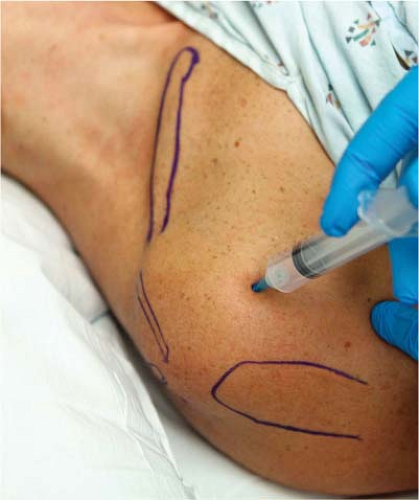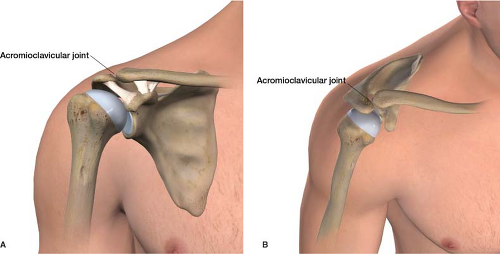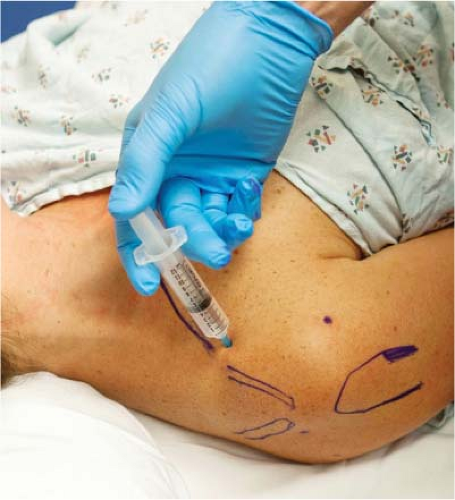Joint and Associated Bursa Injections: Shoulders, Elbows, Hips, and Knees
Joints and their associated bursas can be injected with a corticosteroid and local anesthetic to reduce both pain and inflammation. These injections also help increase the range of motion of painful joints. Injections may be into the joint (intra-articular) in cases of arthritis or next to the joint (para-articular) in cases of bursitis. Bursitis is the painful inflammation of the bursa, a pad-like sac found in the areas subject to friction. Conditions often treated with these injections include osteoarthritis, bursitis, tendinitis, and frozen shoulder.
A number of different local anesthetics and steroids are used in combination for joint and bursa injections. One syringe holds both the local anesthetic and the corticosteroid solution. The local anesthetic is useful because it provides immediate pain relief and confirms proper needle location. It also enables dispersion of steroid in a large joint space or bursa. The corticosteroid is useful because it decreases inflammation in three ways. One, it reduces excess synovial blood flow, which is increased because of vasodilation. Two, it lowers the local leukocyte and inflammatory modulatory response.1–3 Three, it alters collagen synthesis and may, in moderate doses, retard bone and cartilage destruction (Fig. 23-1). In addition, the corticosteroid provides long-lasting pain relief.
Table 23-1 Primary Corticosteroids Currently Available and Their Equivalent Doses | |||||||||||||||
|---|---|---|---|---|---|---|---|---|---|---|---|---|---|---|---|
|
The primary corticosteroids on the market are listed in Table 23-1. There is no particular steroid that is more appropriate over another. I use Kenalog (triamcinolone acetonide) for my injections; standard Kenalog doses are presented in the examples to follow. If you decide to use any other steroid, its proper dose can easily be calculated: For example, 40 mg of Kenalog is equivalent to 6 mg of Celestone (Table 23-1).
Two types of local anesthetics are primarily used for joint and bursa injections: Lidocaine and bupivacaine, which both work by blocking fast voltage-gated sodium channels (Fig. 23-2). This prevents neuronal depolarization, blocking the painful nerve impulses that are sent to the brain. Doses of 1% lidocaine and 0.25% bupivacaine are equivalent to each other; however, they differ in their time of onset and length of duration (Table 23-2). I prefer bupivacaine because of its duration of action, but either local anesthetic is fine.
Table 23-2 Comparison of Action of Lidocaine and Bupivacaine | |||||||||
|---|---|---|---|---|---|---|---|---|---|
|
The following guidelines should be followed for joint and associated bursa injections. The total volume injected into medium-size joints such as the elbow, can be 2 mL. The total volume injected into larger-size joints such as the shoulders, hips, or knees can be 5 mL. The most common ratio of local anesthetic to corticosteroid is 2:1 or 3:1.
Repeated steroid injections for osteoarthritis are safe and do not accelerate disease progression.4 Studies suggest that cartilage damage over time in patients with osteoarthritis is likely caused by the underlying disease rather than any deleterious effect of steroids. The recommended interval between intra-articular injections is 3 months.5
When to use
There are three primary reasons for joint and bursa injections.
The first reason is curative, in cases such as greater trochanteric bursitis (hips). After a single injection for greater trochanteric bursitis, patients often report a prolonged improvement in pain and disability.6 A 2005 paper reported that in a 5-year follow-up there was a 2.7-fold increase in the number of patients who were pain free after a single corticosteroid injection compared with those who did not receive an injection.7 In cases such as lateral epicondylitis (tennis elbow), corticosteroid injections are superior to nonsteroidal drug therapy and physical therapy before 6 weeks.8,9
The second reason is provision of a pain-free window. Often this gives the patient an ability to participate fully in physical therapy. Complete participation in rehabilitative exercises may lead to the resolution of forms of tendinopathy or bursitis.
The third reason is diagnostic, to help determine if pain is coming from the primary site or is referred: For example, identifying the hip as a main pain generator rather than being referred from the lumbar spine via a diagnostic block. If the patient has pain relief with a local anesthetic in the hip joint, it is most likely the pain generator and not referred from the back. This helps protect the patient from undergoing the needless pursuit of competing diagnoses, and from undergoing presumptive treatment that is not appropriate.
How to Perform the Procedure
Shoulder Region
The shoulder is a ball and socket joint. The ball is the top, rounded part of the humerus; the socket is the outer edge of the scapula (the glenoid, Fig. 23-3). The joint is held together by muscles, ligaments, and tendons. This joint is flawed by design. The ball is too big for the relatively flat socket. This allows for the joints significant range of motion. The glenohumeral joint is a common pain generator. Patients also have pain at the superior aspect of the shoulder, where the clavicle and the acromion (part of the scapula) join. This area, commonly referred to as the acromioclavicular (AC) joint, is subject to friction, and consequently arthritis. Bursitis of the shoulder occurs at the subacromial bursa, which separates the supraspinatus tendon (one of the four tendons of the rotator cuff) from the coracoid process ligament (Fig. 23-4). When the arm is resting at the side, the subacromial bursa lies laterally below the acromion. When the arm is abducted, it moves medially beneath the bone where it can be impinged. To better understand which type of shoulder injection is appropriate for your patient, see the shoulder pain section of Chapter 1, Musculoskeletal Pain.
Shoulder (Glenohumeral) Joint Injection
The patient is seated. The major landmark for this joint is the coracoid process (Fig. 23-5). Standing in front and just lateral to the painful shoulder, this knob of bone can be palpated. The injection point is 2 cm lateral to the inferior edge of the coracoid. Mark an “X” on this point using a felt-tip marking pen. The skin is prepped with betadine. A 5-mL syringe should be filled with a mixture of local anesthetic and steroid; an 18-gauge needle is used to draw up the medication. The needle is then removed once the medications have been drawn up and a 1.5-in, 25-gauge needle is employed next. A longer
needle may be needed on larger patients. I use a mixture of 3 mL of 0.25% bupivacaine and 40 mg of Kenalog as my therapeutic agent. The needle is placed through the “X” that was marked on the skin (Fig. 23-6). The needle is advanced toward the humeral head until the needle tip touches bone. The needle is retracted 1 to 2 mm and the therapeutic agent is injected. The needle is then withdrawn, the betadine wiped away, and a bandage is placed. The patient is asked to move the shoulder through a full range of motion, which helps to distribute the therapeutic solution.
needle may be needed on larger patients. I use a mixture of 3 mL of 0.25% bupivacaine and 40 mg of Kenalog as my therapeutic agent. The needle is placed through the “X” that was marked on the skin (Fig. 23-6). The needle is advanced toward the humeral head until the needle tip touches bone. The needle is retracted 1 to 2 mm and the therapeutic agent is injected. The needle is then withdrawn, the betadine wiped away, and a bandage is placed. The patient is asked to move the shoulder through a full range of motion, which helps to distribute the therapeutic solution.
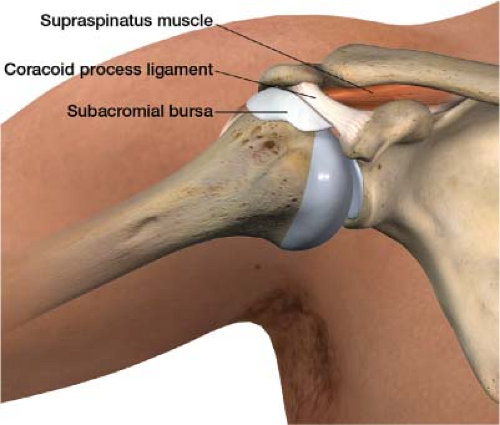 Figure 23-4 The subacromial bursa separating the supraspinatus tendon and coracoid process ligament. |
Shoulder (Acromioclavicular) Joint Injection
The patient is seated. Standing in front and just lateral to the painful shoulder, the clavicle is palpated in a medial to lateral direction. There is a small depression at the lateral aspect of the clavicle that can be tender. This is the AC joint (Fig. 23-7). Mark an “X” on this
point using a felt tip marking pen (Fig. 23-8). The skin is prepped with betadine. A 5-mL syringe should be filled with a mixture of local anesthetic and steroid; an 18-gauge needle is used to draw up the medication. The needle is removed once the medications have been drawn up and a 1.5-in, 25-gauge needle is employed next. I use a mixture of 1 mL of 0.25% bupivacaine and 20 mg of Kenalog as my therapeutic agent. The needle is placed through the “X” that was marked on the skin and advanced toward the target until the needle tip touches bone and then withdrawn 1 to 2 mm. This is very superficial. The therapeutic agent is then injected. The needle is withdrawn, the betadine wiped away, and a bandage is placed.
point using a felt tip marking pen (Fig. 23-8). The skin is prepped with betadine. A 5-mL syringe should be filled with a mixture of local anesthetic and steroid; an 18-gauge needle is used to draw up the medication. The needle is removed once the medications have been drawn up and a 1.5-in, 25-gauge needle is employed next. I use a mixture of 1 mL of 0.25% bupivacaine and 20 mg of Kenalog as my therapeutic agent. The needle is placed through the “X” that was marked on the skin and advanced toward the target until the needle tip touches bone and then withdrawn 1 to 2 mm. This is very superficial. The therapeutic agent is then injected. The needle is withdrawn, the betadine wiped away, and a bandage is placed.
Shoulder (Subacromial Bursa) Injection
The patient is seated. Standing in back and just lateral to the painful shoulder, the lateral posterior edge of the acromion is palpated (Fig. 23-9). Mark an “X” 2 cm below this point using a felt-tip marking pen (Fig. 23-10). The skin is prepped with betadine. A 5-mL syringe should be filled with a mixture of local anesthetic and steroid; an 18-gauge needle is used to draw up the medication. The needle is removed once the medications have been drawn up and a 1.5-in, 25-gauge needle is employed next. I use a mixture of 2 mL of 0.25% bupivacaine and 40 mg of Kenalog as my therapeutic agent. The needle is placed through the “X” that was marked on the skin, with the needle tip pointed cephalad toward the acromion. The needle is advanced toward the target until the tip touches bone, the undersurface of the acromion. The needle is withdrawn 1 to 2 mm. The therapeutic agent is then injected. The needle is withdrawn, the betadine wiped away, and a bandage is placed. The patient is asked to move the shoulder through a full range of motion, which helps to distribute the therapeutic agent.
Stay updated, free articles. Join our Telegram channel

Full access? Get Clinical Tree



